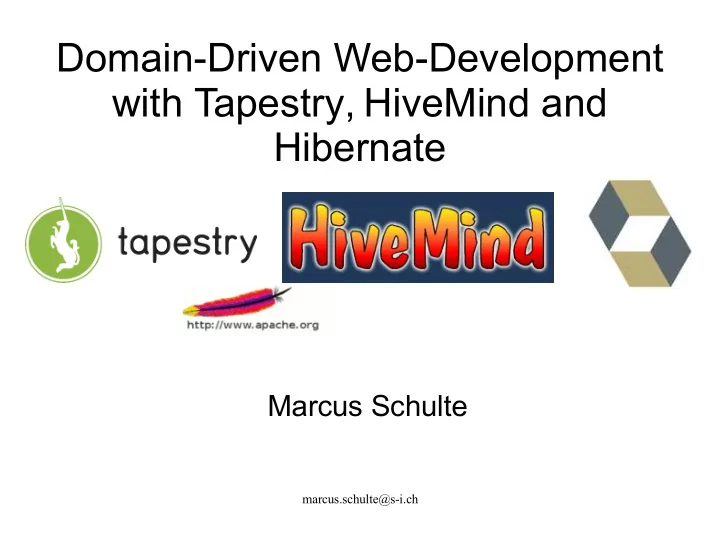

Domain-Driven Web-Development with Tapestry, HiveMind and Hibernate Marcus Schulte marcus.schulte@s-i.ch
Overview ● Background: What were we trying to achieve? ● Why domain-driven? ● Architecture of the foundation frameworks ● Putting it all together – lifecycle of domain- entities ● Bottom-line: advantages and desiderata marcus.schulte@s-i.ch
Non-functional Requirements ● Extra-/Intranet Applications ● 10 to 1000 users, max 100 concurrent ● Relatively complex domain – compared to typical Web-2.0-app, anyway. ● Users cherish snappyness. Response-times above 200 ms makes them call for their 3270s marcus.schulte@s-i.ch
Historical Background ● Started J2EE 2002 ● Back then: – Struts-based home-brewn web-framework (action- centric) – EJB 1.1 architecture based on „Core J2EE patterns“ by Deepak, Alur, et al. ● 2005: re-evaluation, run-time behaviour was good but: tired of technical anomalies. ● Main objective: „pure“ business logic marcus.schulte@s-i.ch
Becoming X-driven ● X= model or X=domain? ● The aim is the same – essentially. ● Continuous abstraction („the Eiffel way“) ● UML-Models tend to be either incomplete or not very abstract. ● Bottom-line: pure Java-domain, no technical slicing of business concerns (PersonEJB, PersonDTO, PersonDAO, PersonDRS, ... ) marcus.schulte@s-i.ch
A Band of Frameworks ● Hibernate – the persistence, EJB-3 ● Tapestry – „an action is a method“ – Reusable components – Java-types make it through the complete request cycle – you deal with objects everywhere – Very clean & customizable architecture ● HiveMind – the glue to assimilate them all – IoC Container – The jar is the component, Beans need interfaces marcus.schulte@s-i.ch
Blueprint marcus.schulte@s-i.ch
HiveMind Use-Cases ● Using a library-module, wiring up an application ● Customising an application or framework by – contributing to configuration points – overriding services ● Managing Service-Instances with service- models ● Aside: Spring got Service-models with 2.0, called the scope of a bean there. marcus.schulte@s-i.ch
Using a HiveMind Library Module marcus.schulte@s-i.ch
Configuration Points ● Modules define configuration points Module A ● Configuration point Config-Point X adhere to schemas ● Any module can contributes to contribute to any configuration point Module B marcus.schulte@s-i.ch
Overriding a Service marcus.schulte@s-i.ch
Service-Models ● Primitive (simple class-instantiation) ● Singleton ● Threaded ● Pooled ● Whatever you want, e.g. „stateful“ <service-point id=“Xyz“> <invoke-factory model=“threaded“> ... </invoke-factory> </service-point> marcus.schulte@s-i.ch
HiveMind Service-Proxies marcus.schulte@s-i.ch
Tapestry starts and a form is submitted ● The App-Servlet instantiates HiveMind Registry ● request comes in, Servlet calls DirectService ● target page pulled from pool ● Service-parameters are decoded, page properties are set up. ● Form rewind is triggered ● Form/button listeners are called ● Response-page renders marcus.schulte@s-i.ch
Tapestry Components marcus.schulte@s-i.ch
Tapestry-Components – Composite Pattern marcus.schulte@s-i.ch
Tapestry Component Interfaces marcus.schulte@s-i.ch
Component Classes ● Simple Java Classes, extending AbstractComponent. Possibly annotated ● Contain (usually): – Abstract property-accessors implemented by the framework (javassist) at runtime. – Listeners – Lifecycle-related callbacks ● Can render their contribution to a page in code or via the associated template (BaseComponent) marcus.schulte@s-i.ch
A Very Simple Component marcus.schulte@s-i.ch
The even Simpler Template marcus.schulte@s-i.ch
marcus.schulte@s-i.ch
Component (Page) Templates <form jwcid="@Form"> <ul> <li jwcid="@For" source="ognl: foos value="ognl: foo" element="li"> Name: <input jwcid="@TextField" value="ognl: foo.name" /> <button jwcid="@Submit" tag="ognl: foo" selected="ognl: fooToBeDeleted" action="ognl:listeners.onDelete" value="delete"/> </li> </ul> </form> marcus.schulte@s-i.ch
Page-Class (for previous Template) public abstract class ListOfFoos extends TestAppBasePage { public abstract Foo getFoo(); public abstract Foo getFooToBeDeleted(); public List<Foo> getFoos() { return getPersistenceService().retrieveAllFoos(); } public void onDelete() { getPersistenceService().delete( getFooToBeDeleted() ); } } marcus.schulte@s-i.ch
Libraries of Components ● Everything inside one jar (templates, images, css, javascript, classes, messages) ● Separate namespace ● Can include HiveMind services/contributions <library-specification> <meta key="org.apache.tapestry.component-class-packages" value="com.javaforge.honeycomb.tapestry"/> <component-type type="ExcelTableLink" specification-path="excel/ExcelTableLink.jwc"/> <component-type type="ExcelIcon" specification-path="excel/ExcelIcon.jwc"/> <component-type type="Watch" specification-path="components/Watch.jwc"/> </library-specification> marcus.schulte@s-i.ch
Examples for Powerful Components ● @PropertySelection, @contrib:Palette ● @tacos:Tree ● @contrib:Table and @honey:ExcelLink ● @bmw:ResourceLink @bmw:ReportView ● @contrib:BeanForm (not yet tried myself) Come with HiveMind Engine-Service marcus.schulte@s-i.ch
Hibernate – the not-so-plain POJOs ● Domain classes can be POJCs ● But: That doesn't make their instances POJOs. ● Hibernated Entities grow – proxies and lazy collections, – associations to the session in which they were loaded (dangling reference, when closed) ● Think carefully about your session, units-of- work, working-copy ● LazyInitializationException and NonUniqueObjectException crop up otherwise marcus.schulte@s-i.ch
Session per Conversation ● The life of the first level cache may exceed the life of a request (stateful persistence service) ● An entities in-memory representation (working copy) must not outlive the session in which it was loaded ● No need for detach/re-attach and correct „merge“-mappings ● See also: Seam and http://hibernate.org/42.html marcus.schulte@s-i.ch
marcus.schulte@s-i.ch
Plugging into Tapestry marcus.schulte@s-i.ch
Honeycomb static marcus.schulte@s-i.ch
Honeycomb dynamic marcus.schulte@s-i.ch
Experience with HiveMind/Tapestry ● Excellent reusability ● Docs sometimes of components incomplete ● Pervasive, rich ● Furiously developed domain model. (Tap 5) ● Great fun for developers ● Good match for Hibernate (s-p-c) ● Actively developed, helpful community marcus.schulte@s-i.ch
Demo & a Duke for Howard marcus.schulte@s-i.ch
Recommend
More recommend